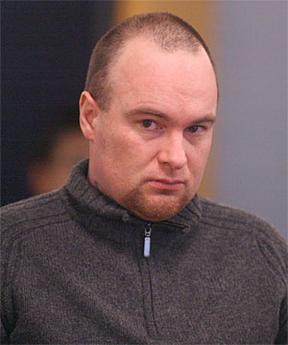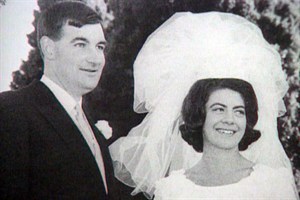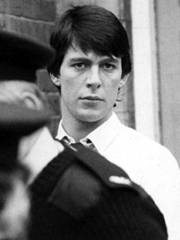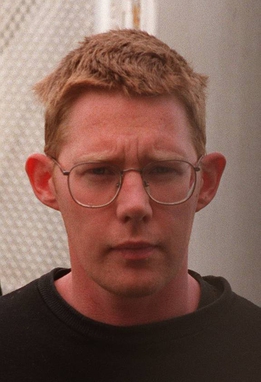George Speight, also known by his pseudonym Ilikimi Naitini, is a Fijian businessman and politician who was the leader of the 2000 Fijian coup d'état, in which he and rebel soldiers from Fiji's Counter Revolutionary Warfare Unit seized the Fijian Parliament and held Prime Minister Mahendra Chaudhry and 35 other MP's hostage from 19 May 2000 to 13 July 2000. After being convicted of treason for leading the coup, he is currently serving a sentence of life imprisonment.

Derek William Bentley was a British man who was hanged for the murder of a policeman during a burglary attempt. Christopher Craig, then aged 16, a friend and accomplice of Bentley, was accused of the murder. Bentley was convicted as a party to the crime under the English law principle of joint enterprise, as the burglary had been committed in mutual understanding and bringing deadly weapons. The outcome of the trial, and Home Secretary David Maxwell Fyfe's failure to grant clemency to Bentley, were highly controversial.

The Einsatzgruppen trial was the ninth of the twelve trials for war crimes and crimes against humanity that the US authorities held in their occupation zone in Germany in Nuremberg after the end of World War II. These twelve trials were all held before US military courts, not before the International Military Tribunal. They took place in the same rooms at the Palace of Justice. The twelve US trials are collectively known as the "Subsequent Nuremberg trials" or, more formally, as the "Trials of War Criminals before the Nuremberg Military Tribunals" (NMT).
Mandatory sentencing requires that offenders serve a predefined term of imprisonment for certain crimes, commonly serious or violent offenses. Judges are bound by law; these sentences are produced through the legislature, not the judicial system. They are instituted to expedite the sentencing process and limit the possibility of irregularity of outcomes due to judicial discretion. Mandatory sentences are typically given to people who are convicted of certain serious and/or violent crimes, and require a prison sentence. Mandatory sentencing laws vary across nations; they are more prevalent in common law jurisdictions because civil law jurisdictions usually prescribe minimum and maximum sentences for every type of crime in explicit laws.

Capital punishment – the process of sentencing convicted offenders to death for the most serious crimes and carrying out that sentence, as ordered by a legal system – first appeared in New Zealand in a codified form when New Zealand became a British colony in 1840. It was first carried out with a public hanging in Victoria Street, Auckland in 1842, while the last execution occurred in 1957 at Mount Eden Prison, also in Auckland. In total, 85 people have been lawfully executed in New Zealand.

The Fiji coup d'état of 2000 was a civilian coup d'état by hardline i-Taukei nationalists against the elected government of an Indo-Fijian Prime Minister, Mahendra Chaudhry on 19 May 2000. This was followed by an attempt on 27 May by President Ratu Sir Kamisese Mara to assert executive authority, and then by a military coup on 29 May by Republic of Fiji Military Forces Commander Commodore Frank Bainimarama. The coups resulted in the removal of the elected government and its replacement by an interim regime headed by Josefa Iloilo. In March 2001 the Court of Appeal of Fiji ruled that the coups and interim regime were illegal. An elected government was finally restored by the 2001 Fijian general election.
William Dwane Bell is a New Zealand triple murderer. He committed a triple murder on 8 December 2001 at the Panmure RSA, after they fired him. He committed the murders while out on parole for a previous aggravated robbery in which he almost killed a service station attendant. He had more than 100 prior criminal convictions, including theft, fraud, unlawful taking of motor vehicles, aggravated robbery, presenting a firearm, impersonating police, and assault. He was given a 30-year minimum non-parole life sentence, at the time the longest minimum non-parole period ever given out by New Zealand.
Auckland Prison is a prison facility consisting of medium security and maximum security compounds in Paremoremo, Auckland, New Zealand. The two compounds are separate but located close together in a rural area.

Antonie Dixon was a convicted New Zealand thief and murderer. His most notorious crimes were committed in an 11-hour spree of violence in 2003 in which he completely or partially severed the hands or arms of two women with a Samurai sword, shot a man dead with a homemade sub-machine gun and kidnapped another man. Dixon acquired over 150 convictions, mostly for theft and burglary; he was imprisoned at least 14 times. His former girlfriend Simonne Butler said he used methamphetamine from at least 2001.

David Harvey Crewe and Jeannette Lenore Crewe were a New Zealand farming couple who were shot to death in their home on or about 17 June 1970. The murders led to the wrongful conviction and subsequent pardoning of another farmer who lived in the district, Arthur Allan Thomas. A Royal Commission set up to investigate the miscarriage of justice found that a detective had fabricated evidence and placed it at the scene of the crime. No person was ever charged with planting the evidence, and the murders remain unsolved.
The Ozone Park Boys, also known as "Liberty Posse" and "The Young Guns", are a Gambino crime family Mafia crew based in Ozone Park, Queens. They are infamous for their massive number of crimes, including an illegal $30 million-a-year sports gambling enterprise.
Abduwali Abdulkadir Museعبدالولي موسى is a Somali convicted pirate. He is the sole survivor of four pirates who hijacked the MV Maersk Alabama in April 2009 and then held Captain Richard Phillips for ransom. On 16 February 2011, Muse was sentenced to 33 years and 9 months in U.S. federal prison.

The United States Penitentiary, Big Sandy is a high-security United States federal prison for male inmates in unincorporated Martin County, Kentucky, near the city of Inez. It is operated by the Federal Bureau of Prisons, a division of the United States Department of Justice. The facility also has a satellite prison camp which houses minimum-security male inmates.

Jeremy Nevill Bamber is a British convicted mass murderer. He was convicted of the 1985 White House Farm murders in Tolleshunt D'Arcy, Essex, in which the victims included Bamber's adoptive parents, Nevill and June Bamber; his adoptive sister, Sheila Caffell; and his sister's six-year-old twin sons. Returning a majority guilty verdict, the jury found that, after committing the murders to secure a large inheritance, Bamber had placed the rifle in the hands of his 28-year-old sister, who had been diagnosed with schizophrenia, to make the scene appear to be a murder–suicide.

The Head Hunters Motorcycle Club are an outlaw motorcycle club in New Zealand. They are found all around the North Island, but are mainly based in East Auckland, with its headquarters being located in Ellerslie. They also have chapters in West Auckland, Wellsford, Northland and Wellington. They have a long criminal history, with more than 1000 notable criminal convictions.

Jorgensen v News Media (Auckland) Ltd [1969] NZLR 961 is a New Zealand defamation case, where the plaintiff Ronald Jorgensen whom despite being convicted for murder involving one of New Zealand's most notorious killings, the Bassett Road machine gun murders, found that the defendant's newspaper referring to him to being involved in the murders was libelous.
Colin Maurice Nicholson was a New Zealand lawyer and jurist. He served as a judge of the High Court of New Zealand from 1998 until 2009. He also served as a justice of the High Court of the Cook Islands from his appointment in April 2005 until his retirement in May 2012. In 2011, Nicholson became the first judge to prosecute citizens of the Cook Islands for counterfeit DVD piracy.

Christopher John Lewis was a New Zealand criminal who made an unsuccessful attempt to assassinate Queen Elizabeth II in 1981. He planned later attempts at assassinating other British royal family members but was kept away from them by the authorities in New Zealand.
The Larnoch Road murders is a controversial double-murder case in Auckland, New Zealand. On 21 August 1989, Deane Wade Fuller-Sandys, a 21-year-old Auckland tyre-fitter, left home to go fishing. He never returned. His body was never found and authorities initially believed he probably drowned after being swept out to sea at West Auckland's Whatipu Beach, where his car was discovered shortly afterwards. An old friend of Fuller-Sandys later told police that he may have committed suicide, as he had just broken up with his girlfriend.

The Bandidos Motorcycle Club is classified as a motorcycle gang by law enforcement and intelligence agencies in numerous countries. While the club has denied being a criminal organization, Bandidos members have been convicted of partaking in criminal enterprises including theft, extortion, prostitution, drug trafficking and murder in various host nations.












